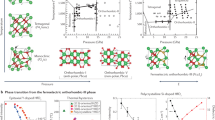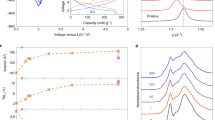Abstract
Combining functionalities in devices with high performances is a great challenge that rests on the discovery and optimization of materials. In this framework, layered oxides are attractive for numerous purposes, from energy conversion and storage to magnetic and electric properties. We demonstrate here the oxygen storage ability of ferroelectric LuFe2O4+x within a large x range (from 0 to 0.5) and its cycling possibility. The combination of thermogravimetric analyses, X-ray diffraction and transmission electron microscopy evidences a complex oxygen intercalation/de-intercalation process with several intermediate metastable states. This topotactic mechanism is mainly governed by nanoscale structures involving a shift of the cationic layers. The ferrite is highly promising because absorption begins at a low temperature ( ), occurs in a low oxygen pressure and the uptake of oxygen is reversible without altering the quality of the crystals. The storage/release of oxygen coupled to the transport and magnetic properties of LnFe2O4 opens the door to new tunable multifunctional applications.
), occurs in a low oxygen pressure and the uptake of oxygen is reversible without altering the quality of the crystals. The storage/release of oxygen coupled to the transport and magnetic properties of LnFe2O4 opens the door to new tunable multifunctional applications.
This is a preview of subscription content, access via your institution
Access options
Subscribe to this journal
Receive 12 print issues and online access
$259.00 per year
only $21.58 per issue
Buy this article
- Purchase on Springer Link
- Instant access to full article PDF
Prices may be subject to local taxes which are calculated during checkout






Similar content being viewed by others
References
McEvoy, A. J. Materials for high-temperature oxygen reduction in solid oxide fuel cells. J. Mater. Sci. 36, 1087–1091 (2001).
Arico, A. S., Bruce, P., Scrosati, B., Tarascon, J. M. & Van Schalkwijk, W. Nanostructured materials for advanced energy conversion and storage devices. Nature Mater. 4, 366–377 (2005).
Shao, Z. P. & Haile, S. M. A high-performance cathode for the next generation of solid-oxide fuel cells. Nature 431, 170–173 (2004).
Kim, S. D. et al. Ni-YSZ cermet anode fabricated from NiO-YSZ composite powder for high-performance and durability of solid oxide fuel cells. Solid State Ion. 178, 1304–1309 (2007).
Kehoe, A. B., Scanlon, D. O. & Watson, G. W. Role of lattice distortions in the oxygen storage capacity of divalent doped CeO2 . Chem. Mater. 23, 4464–4468 (2011).
Remsen, S. & Dabrowski, B. Synthesis and oxygen storage capacities of hexagonal Dy1−xYxMnO3+δ . Chem. Mater. 23, 3818–3827 (2011).
Carter, S. et al. Oxygen transport in selected nonstoichiometric perovskite-structure oxides. Solid State Ion. 53–56, 597–605 (1992).
Karppinen, M. et al. Oxygen non stoichiometry in YBaCo4O7+δ: Large low-temperature oxygen absorption/desorption capability. Chem. Mater. 18, 490–494 (2006).
Sakai, N. et al. Structure and transport property of manganese–chromium–iron oxide as a main compound in oxide scales of alloy interconnects for SOFCs. Solid State Ion. 176, 681–686 (2005).
Hayward, M.A. Structural and magnetic properties of topotactically reduced YSr2Mn2O7−x (0<x<1.5). Chem. Mater. 18, 321–327 (2006).
Bredesen, R., Norby, T., Bardal, A. & Vibeke, L. Phase relations, chemical diffusion and electrical conductivity in pure and dopes Sr4Fe6O13 mixed conductors materials. Solid State Ion. 135, 687–697 (2000).
Fisher, C. A. J. & Islam, M. S. Mixed ionic/electronic conductors Sr2Fe2O5 and Sr4Fe6O13: atomic-scale studies of defects and ion migration. J. Mater. Chem. 15, 3200–3207 (2005).
Ikeda, N. et al. Ferroelectricity from iron valence ordering in the charge-frustrated system LuFe2O4 . Nature 436, 1136–1138 (2005).
Cheong, S-W. & Mostovoy, M. Multiferroics: A magnetic twist for ferroelectricity. Nature Mater. 6, 13–20 (2007).
Isobe, M., Kimizuka, N., Iida, J. & Takekawa, S. Structures of LuFeCoO4 and LuFe2O4 . Acta Crystallogr. C 46, 1917–1918 (1990).
Bourgeois, J. et al. Evidence of oxygen-dependent modulation in LuFe2O4 . Phys. Rev. B 85 064102 (2012).
Iwata, M. & Ishibashi, Y. Possible commensurate phases in LuFe2O4 . J. Phys. Soc. Jpn 81, 035003 (2012).
Hervieu, M. et al. Nanostructures in LuFe2O4−δ . Solid State Sci. 23, 26–34 (2013).
Cao, S. et al. Extreme chemical sensitivity of nonlinear conductivity in charge-ordered LuFe2O4 . Sci. Rep. 2, 330 (2012).
Wang, F. et al. Oxygen stoichiometry and magnetic properties of LuFe2O4+δ . J. Appl. Phys. 113, 063909 (2013).
Christianson, A. D. et al. Three-dimensional magnetic correlations in multiferroic LuFe2O4 . Phys. Rev. Lett. 100, 107601 (2008).
Patankar, S. et al. Tuning the magnetic properties of the multiferroic LuFe2O4 by moderate thermal treatment. Euro Phys. Lett. 90, 57007 (2010).
Gérardin, R., Nodari, I., Aqachmar, H. & Evrard, O. Mise en évidence de deux nouvelles familles de ferrites de lanthanoïdes Ln2Fe4O9 et Ln4Fe6O15 . C. R. Acad. Sci. 295, 863 (1982).
Gérardin, R., Aqachmar, H., Nodari, I., Brice, J. F. & Evrard, O. Contribution à l’étude du système Lu2O3–Mn2O3–Fe2O3 et caractérisation de deux variétés cristallographiques de Lu2Mn2Fe2O9 . J. Phys. Chem. Solids 50, 43–48 (1989).
Zhang, Y., Yang, H. X., Ma, C., Tian, H. F. & Li, J. Q Charge-stripe order in electronic ferroelectric LuFe2O4 . Phys. Rev. Lett. 98, 247602 (2007).
Maruyama, T., Murakami, Y., Shindo, D., Abe, N. & Arima, T. Observations of charge-ordered and magnetic domains in LuFe2O4 using transmission electron microscopy. Phys. Rev. B 86, 054202 (2012).
Yamada, Y., Kitsuda, K., Nohdo, S. & Ikeda, N. Charge and spin ordering process in the mixed-valence system LuFe2O4: Charge ordering. Phys. Rev. B 62, 12167–12174 (2000).
Wu, W. et al. Formation of pancakelike Ising domains and giant magnetic coercivity in ferrimagnetic LuFe2O4 . Phys. Rev. Lett. 101, 137203 (2008).
Van Tendeloo, G. & Amelinckx, S. The origin of diffuse intensity in electron diffraction patterns. Phase Transit. 67, 101–135 (1998).
Armand, M. & Tarascon, J. M. Building better batteries. Nature 451, 652–657 (2008).
Wagemaker, M., Borghols, W. J. H. & Mulder, F. M. Large impact of the particle size on insertion reactions. A case for anatase LixTiO2 . J. Am. Chem. Soc. 129, 4323–4327 (2007).
Grenier, J-C., Wattiaux, A., Demourgues, A., Pouchard, M. & Hagenmuller, P. Electrochemical oxidation: A new way for preparing high oxidation states of transition metals. Solid State Ion. 63–65, 825–832 (1993).
Bourgeois, J. et al. Evidence of magnetic phase separation in LuFe2O4 . Phys. Rev. B 86, 024413 (2012).
Delmas, C., Braconnier, J-J., Fouassier, C. & Hagenmuller, P. Electrochemical intercalation of sodium in NaxCoO2 bronzes. Solid State Ion. 3–4, 165–169 (1981).
Kim, S., Ma, X., Ping Ong, S. & Ceder, G. A comparison of destabilization mechanisms of the layered NaxMO2 and LixMO2 compounds upon alkali de-intercalation. Phys. Chem. Chem. Phys. 14, 15571–15578 (2012).
Paulus, W., Heger, G., Rudolf, P. & Schöllhorn, R. In situ neutron diffraction studies on the electrochemical oxidation of polycrystalline La2CuO4 . Physica C 235-240, 861–862 (1994).
Villesuzanne, A. et al. On the role of lattice dynamics on low-temperature oxygen mobility in solid oxides: A neutron diffraction and first-principles investigation of La2CuO4+δ . J. Solid State Electrochem. 15, 357–366 (2011).
Nagai, Y. et al. X-ray absorption fine structure analysis of local structure of CeO2–ZrO2 mixed oxides with the same composition ratio (Ce/Zr = 1). Catal. Today 74, 225–234 (2002).
Gai, P. L. A new structural transformation mechanism in catalytic oxides. Acta Crystallogr. B 53, 346–352 (1997).
Rodriguez-Carvajal, J. Recent advances in magnetic structure determination by neutron powder diffraction. Physica B 192, 55–69 (1993).
Acknowledgements
This work was supported by financial support from the French Agence Nationale de la Recherche (ANR-08-BLAN-0005-01 and JC08-331297). The authors thank M. T. Sougrati (Institut Charles Gerhardt) for Mössbauer experiments.
Author information
Authors and Affiliations
Contributions
The samples were prepared by J.B., magnetic properties were measured by M.P. and A.M., E.E. collected the synchrotron XRD data, A.G. and C.M. analysed TGA data and XRD diffractograms, and M.H. performed the electron microscopy observations and data analysis. The manuscript was written by M.H. and C.M. and revised by F.D., J.R., A.G. and A.M. The project direction was developed by F.D. and C.M.
Corresponding author
Ethics declarations
Competing interests
The authors declare no competing financial interests.
Supplementary information
Supplementary Information
Supplementary Information (PDF 814 kb)
Rights and permissions
About this article
Cite this article
Hervieu, M., Guesdon, A., Bourgeois, J. et al. Oxygen storage capacity and structural flexibility of LuFe2O4+x (0≤x≤0.5). Nature Mater 13, 74–80 (2014). https://doi.org/10.1038/nmat3809
Received:
Accepted:
Published:
Issue Date:
DOI: https://doi.org/10.1038/nmat3809
This article is cited by
-
Pressure-induced charge orders and their postulated coupling to magnetism in hexagonal multiferroic LuFe2O4
npj Quantum Materials (2023)
-
Direct evidence of electronic ferroelectricity in YbFe2O4 using neutron diffraction and nonlinear spectroscopy
Scientific Reports (2021)
-
Rare earth barium cobaltites: potential candidates for low-temperature oxygen separation
SN Applied Sciences (2020)
-
Magnetic oxygen stored in quasi-1D form within BaAl2O4 lattice
Scientific Reports (2019)
-
Comparative Study on the Charge-Ordered and Mixed-Valence Phases of LuFe2O4 via First-Principles Calculations
Journal of Superconductivity and Novel Magnetism (2018)



